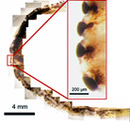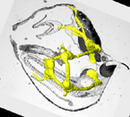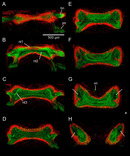Diploma Thesis
"Zur Neuroanatomie, Histologie und Feinstruktur des Visceralganglions bei Barbatia barbata (Arcidae, Bivalvia)"
 Besides the fact that eyes, or at least photoreceptors, are present within almost every animal group, today’s level of knowledge of animal vision is fragmentary in respect to the overall subject. The research focuses on vertebrates, but in invertebrates there are also known visual systems of different quality (e.g. temporal and spatial resolution, color vision, polarization vision). These qualities rely on the constitution of the peripherally photoreceptive organs as well as on the process performance of visual information in the CNS.
Besides the fact that eyes, or at least photoreceptors, are present within almost every animal group, today’s level of knowledge of animal vision is fragmentary in respect to the overall subject. The research focuses on vertebrates, but in invertebrates there are also known visual systems of different quality (e.g. temporal and spatial resolution, color vision, polarization vision). These qualities rely on the constitution of the peripherally photoreceptive organs as well as on the process performance of visual information in the CNS.
In this study first structural insights into the central visual system, namely the visceral ganglion, of the bivalve mollusk Barbatia barbata are provided.
To achieve this goal, several methods have been applied:
- 3D-reconstructions with Amira® of a whole animal and separated visceral ganglia
- antibody staining
- tracing studies (with lipophilic fluorescence dyes)
- electron microscopy (TEM).
The visceral ganglion receives input from the pallial nerves, which arise from the mantle edge. These nerves consist amongst others (e.g. motor neurons) of optic fibers from the numerous eyes. To some extent, it had been possible to stain discrete nerve tracts originating from the pallial nerves and to follow them up through several layers of the visceral ganglion. Although the final projections of the optic fibers could not be located, trends of directions were elaborated.
The comparison with already published data revealed that the visceral ganglion of
B. barbata - a species with complex cap and simple cup eyes - does not reach the complexity of that of Pecten - a genus with lens eyes.
An estimate of the visual input into the ganglion examines that about 20 - 30 percent of the pallial nerves are consisting of optic fibers. Furthermore, up to 600 eyes in one animal (33 mm) can be found. In combination with the high complexity of the compound eyes, it is likely to presume that the visual ability of B. barbata is not of simple construction, even though these animals are living underneath stones.








